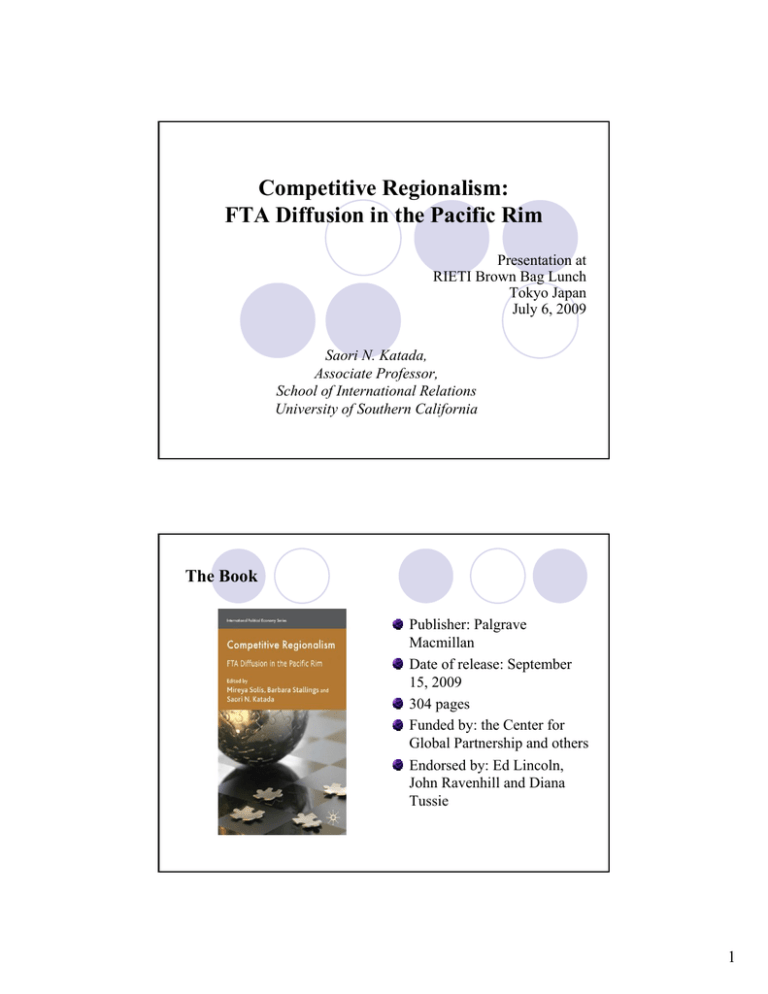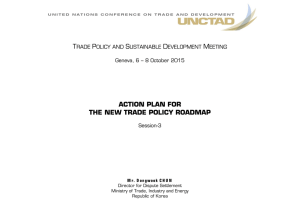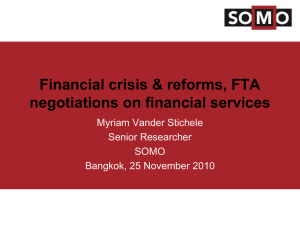Competitive Regionalism: FTA Diffusion in the Pacific Rim
advertisement

Competitive Regionalism: FTA Diffusion in the Pacific Rim Presentation at RIETI Brown Bag Lunch Tokyo Japan July 6, 2009 Saori N. Katada, Associate Professor, School of International Relations University of Southern California The Book Publisher: Palgrave Macmillan Date of release: September 15, 2009 304 pages Funded by: the Center for Global Partnership and others Endorsed by: Ed Lincoln, John Ravenhill and Diana Tussie 1 Three Editors: Mireya, Barbara and Saori The Chapter Contributors Ch Title (shortened) Authors 1 Explaining FTA Proliferation: Framework Solís and Katada 2 Exclusion Fears and Competitive Regionalism Shujiro Urata 3 Political-Security Competition and the FTA Movement Mike Mochizuki 4 Competitive Rule-making: Standard Setting & Locking-in Junji Nakagawa 5 The US as a Bilateral Player Quiliconi and Wise 6 Chile: A Pioneer in Trade Policy Barbara Stallings 7 Mexico’s FTA Strategy Aldo Flores-Quiroga 8 Southeast Asia and Beyond: Role of Singapore & ASEAN Takashi Terada 9 South Korea’s FTAs Min Gyo Koo 10 Japan’s Competitive FTA Strategy Mireya Solís 11 China’s Competitive FTA Strategy Jian Yang 12 Conclusion Stallings and Katada 2 The Number of FTAs Reported to GATT/WTO FTA Diffusion by Proliferation 3 Main Questions of the Project What is driving the worldwide explosion of FTAs? Why is it more likely for states to establish a new bilateral FTA than to join existing ones? Can FTA network represent the foundation for much more ambitious projects of regional integration and collaboration? Main Arguments The FTA policies influenced by the externalities generated by prior actions of their peers. Pacific Rim governments’ FTA policies are affected by the need to respond to multiple competitive pressures. The competitive dynamics lead to proliferation of FTAs, and such dynamics have negative implications on regionalism. 4 Existing Literature Economic interdependence Neofunctionalism: Haas (1964) to Mattli (1999) Domestic lobbying and rent-seeking Specific producer groups (Grossman & Helpman 1995) State autonomy Intergovernmentalism (Moravcsik 1991) Latin America: From inward to outward looking integration (Feinberg, 2002) US-led “competitive liberalization” (Evenett and Meier 2008) East Asia: Influence of developmental state (Bowles 2002) Domestic lobbying (Katzenstein 2006) Relation to the multilateral trading system (Aggarwal 2005) The Analytics of FTA diffusion Î Diffusion literature (Strang 1991, Elkins and Simmons 2005, IO Fall 2006, and Simmons, Dobbin and Garrett 2008) Diffusion occurs when: the prior adoption of a trait or practice in a population alters the probability of adoption for remaining non-adopters ~ interdependence of government choices Applied to; liberal economic policies, democracy etc. FTAs: government’s policy to adopt FTA policy is influenced by the actions of other countries. Novelty: Focus on the explicit and implicit link among FTAs 5 Hypotheses Null hypothesis: FTA policy launched independently and autonomously. Emulation hypothesis: FTA policies disseminate through countries copying their socio-cultural peers and leading nations. Such process leads to multidirectional FTA proliferation with similar partners. Competitive hypothesis: Governments counteract the FTA policies of their competitors. Such process leads to selective FTA proliferation with eclectic partners. Emulation versus Competition 6 Unpacking “Competitive Mechanism” Competition as a multi-dimensional process Economic competition: Race to obtain relative gains from trade creation and becoming a trade hub or attracting FDI. Cost of trade diversion. Political/security competition: A part of balancing and accommodating foreign policy strategy and to overcome security vulnerability. Legal competition Bottom-up standard-setting and rule-making. Country Case I: Chile 7 Country Case I: Chile NAFTA kicked off an emulation strategy in 1994. Newly democratized country strove to reintegrate into Latin American region. Also pursues prestige as an FTA hub in the Pacific Rim. Experiences the “spaghetti bowl” of FTAs under two different modalities (NAFTA versus ECAs). Chile is seen (especially by Mercosur) as an agent that undermines the regional integration. Country Case II: China 8 Country Case II: China As the WTO stalled, China showed willingness to learn from other FTAs (emulative process). Shows realist calculation as a criteria for FTA partner selection (e.g. resources), and rivalry with Japan. To overcome China’s declining cost competitiveness, protect its industries with ROO application, and pursue “market economy” recognition. Uses FTAs to overcome possible trade blocs in other regions (e.g. FTAA). Strong interest in regional trade integration and uses FTAs to secure China’s leadership in East Asia. Emulation and Competition as FTA Triggers 9 Dominant Type of Competition In Conclusion FTA proliferation exhibits diffusion dynamics. Both emulation and competition are motivating forces behind FTA adoption by the Pacific countries. Small countries tend to respond more to economic competition, while large countries react more to political and legal competition. FTA diffusion through competition creates unruly FTA networks and political rivalry, making it less likely for smooth regional trade integration project to emerge. 10



